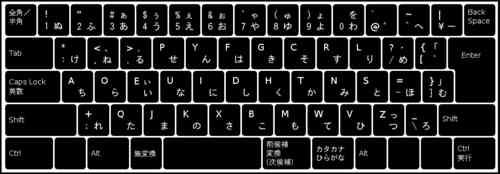
(Dvorak JP106 v0.1. Full size: Black White Grey GIMP .xcf)
English | Japanese (日本語)
(Not to be confused with DvorakJP (Japanese only))

(Dvorak JP106 v0.1. Full size:
Black
White
Grey
GIMP .xcf)
A number of people nowadays are looking into learning the Dvorak Simplified Keyboard. I myself have tried in the past to switch, but due to schoolwork at the time I could not afford the temporary sacrifice in speed that switching imposes. Now, living in Japan I have sufficient free time and a light enough work load that I can safely switch, but there's a problem: I've been unable to find a Dvorak layout for Japanese 106-key keyboards. So, I've tried to fill the gap.
This is my attempt at creating a Dvorak-style keyboard layout for Japanese keyboards. For the few people who have been searching for something like this, I hope it may be useful.
Currently, implementations of this are rather hackish. For Windows 2000/XP, I have a registry patch which will add scancode mappings effectively changing a standard JP106 layout into Dvorak JP106. For X.org (Linux and similar), it's a patch to the XKB config files which adds the layouts. The Windows patch will fully meet the spec for version 0.1 of Dvorak JP106, while the X.org patch should at least get the standard layout correct but may not change the kana mode layout.
I've also added a version for the Linux console. Since the standard console (to my knowledge) does not support kana mode, it can also be considered to be completely up to spec.
The JP106 layout and related graphics available on this page are released into the public domain (although attribution would be appreciated). The software implementations of the layout provided on this page are licensed under a BSD-style license.
WARNING: These files have been tested on my personal system, but I strongly advise users to use due caution before applying these patches. These patches modify important system configuration files. Open them up and verify that they haven't been tampered with and that they do what they're supposed to do.
Download and unzip dvorak_jp106_v0.1_win.zip. To change the keymap, execute the .reg file of your choice, and then logout/login to Windows. Be warned: this is a system-wide change, and if your system is password-protected you will have to input your password in Dvorak as well!
Download and extract dvorak_jp106_v0.1_xorg.tar.bz2. Find the directory on your system containing the XKB configuration files. (On my Debian system, this is "/usr/share/X11/xkb".) Open a console, "cd <xkb_dir>", and "patch -Np1 --dry-run -i <patchfile>". If no errors occur, then finalize the patch by running "patch -Np1 -i <patchfile>" with sudo or as root.
Download and extract dvorak_jp106_v0.1_linuxconsole.tar.bz2. It contains a loadkeys-compatible keymap file. (Tested with Debian loadkeys 0.2.3.) If you're running Debian or Debian-based Linux (e.g. Ubuntu), follow the readme file's instructions for installation. Otherwise, you'll have to research how to install this for your specific distribution.
Here is the documentation I wrote up explaining the layout as applied to Windows 2000/XP: dvorak_jp106_v0.1_doc_windows_en.txt
X.org patch will add a new layout for romaji and kana, but I do not yet know how to link the new kana layout to the new romaji one.
Version 0.1 largely follows the design of the standard Dvorak Simplified Keyboard. The alphanumeric characters are in the same positions as standard Dvorak. The symbol keys are a little different since symbol layouts differ between the US and Japanese QWERTY layouts. Symbols on the number keys have been left alone. Other keys have been swapped positionally in the same way that they would between US QWERTY and Dvorak. The symbols on the far right have been partially rearranged based upon what I personally felt was best.
Kana mappings have also been changed. Version 0.1 is a simple remap of the keys to accomodate romaji typing, and kana mode characters are still linked to the characters they originally were. This is necessary since the Windows layout is a simple scancode remapping rather than a proper new layout, which is not simple to do with CJK keyboards on Windows.
Version 0.2 would simply include the original kana mappings together with the new romaji layout. Currently I have no solution for Windows which handles this. X.org users can probably accomplish this with my current patch.